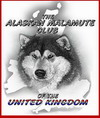 |
Coat Length Genetics |


Tested dogs – result affected
SHOULD BREEDERS TEST FOR THE LONG COAT GENE
There is a test for the long-coat gene for our breed, to determine if our malamute is affected (2 copies of the gene), carrier (1 copy of the gene) or clear (no copies of the gene). Some breeders do not use this stating that it is purely cosmetic, relying on their interpretation of the dogs’ status by sight only. Some breeders use the test and will use a carrier on a clear in the belief they will not produce a long-coat appearing puppy, even though they will produce carriers. Some will not use a carrier and certainly not an untested dog with a long coat.
The condition itself is known to be simple recessive in its mode of inheritance this means that carrier to clear will only produce carriers and clear (in theory not producing the long coat).
Only carriers bred together, affected bred together or affected to carrier will produce the condition. Below is a chart showing the expected outcome over time and puppy numbers of a condition with simple recessive inheritance.

Here’s the bummer…the genetic test will tell you if your dog is clear, carrier or affected but cannot tell you about the modifiers, both long coat and ‘normal’ coat have modifiers, these modify the coat length (short, medium and long) texture too ( harsh, silky, cottony ). Unfortunately, the modifiers that your dog has will affect the coat appearance whatever its genetic status. It’s possible that a confirmed LC with short modifiers has a normal appearance.
Another feature which seems to be present in ‘long coats’ is the benefit of great bone and substance, whether this trait is linked to the LC gene I don’t know but the long coats I’ve seen all have the desirable heavy bone and substance.
Now you see the mistake of judging a book (or a malamute) by its cover (or coat). What you may write off from your breeding programme because of its long-coat appearance may only be a carrier and a potentially valuable addition to a careful breeding programme, also what you may perceive as ‘normal’ coated’ and assumed not affected, could be genetically a long coat, surely an argument for testing your puppies.
Many ‘old time’ breeders used ‘long coats’ in their breeding programmes. They didn’t have the benefit of genetic testing, so could have been using affected or carriers, who knows, but they must have seen the benefits of the occasional long coat in their breeding programmes to keep a ‘good’ coat and maybe good bone too.
We are fortunate to have the benefit of a test which allows us to make informed decisions on breeding.
So from looking like a somewhat insignificant test for purely cosmetic reasons, we can see that it may be a rather important one.
Below are three dogs, all tested LC carriers, showing the variation caused by modifiers |
 |
 |
Very interesting site with loads of pics and descriptions http://www.wayeh.com/wayeh/faq-long-coat.htm
Another informative site http://nicholescritters.homestead.com/malcolorgeneticscoatlength.html
Sue Thompson & Keith Givens
SHOMONT